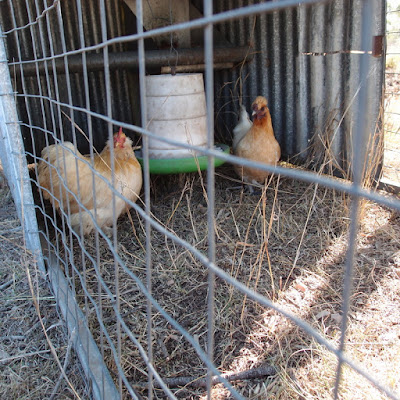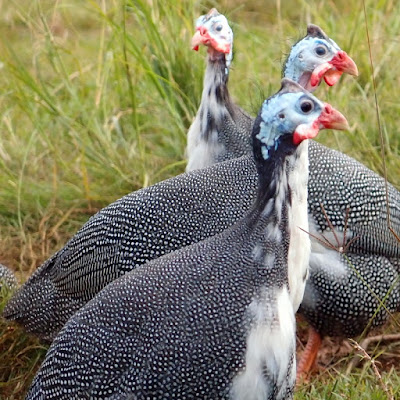Recently I picked up one of our hens to check her for external parasites and found her to be crawling with them. So many that when I put her down, they were crawling on me too! In the past we have treated our chickens with Maldison when we found the chickens to have external parasites. We only found out that the chickens had parasites that time because a couple of them dropped dead. Since then, we check the chickens more regularly, any time I can catch a hen I will check her for parasites. Usually they are fine, we haven't had any issues for about two years, but now the bugs are back.
 |
poor rooster, all the hens took off into the bushes and left him,
they really don't like being wet |
As our chickens free-range most days, they have plenty of opportunity to have contact with wild birds and the parasites that they carry. They also have opportunity to dust bathe, which helps them to stay bug-free. I think moving the tractors regularly helps too. My theory is that we just got a big slack about cleaning out the nesting boxes and the bugs have managed to get established. This is a good reminder that is important to keep everything clean.
I didn't want to use Maldison to treat the parasites this time because its one of the chemicals that the
WHO recently rated as "probably causing cancer" (
also reported here). We have also used Pestene, but the active ingredient rotonone, while technically natural and allowed in organic farming, has
also been linked to health problems. Other sites suggest dog or cat flea treatments, I don't even use them on the dogs, so I don't want them on the chickens either (
we do use tick collar because we live in a paralysis tick area).
I wanted to try neem oil because I've found it so effective against other insects lately (more to come about neem oil in future posts, but check out
what I wrote about neem oil back here). We made up a 5% solution of neem oil in water with a little detergent, in a large bucket, caught each chicken and dunked them in the liquid. We also cleaned out the nesting boxes and refreshed them with diatomaceous earth and wood shavings (diatomaceous earth is another excellent insect killer,
see more details here).
 |
| bucket of neem solution for dunking infested chickens |
We checked each chicken before we dunked it in the neem oil solution, just to get an idea of how many were infested, and we did notice that there were two types of bugs. I didn't find out until later that the chickens had
both lice and mites. It turns out that this is an important detail. The lice just camp out on the chickens skin and feed on the feather follicles, they lay eggs in the feathers and you will see big balls of eggs around the feathers near the chicken's vent if it has a bad infestation.
While lice will just irritate the chickens and make them uncomfortable, mites actually suck the chicken's blood and can cause serious problems, even death. I suspect that's what we had the first time when the chickens died, although we only saw lice at the time (I remember those huge balls of eggs!). There are also
several types of mites, some live on the chickens all the time and some live in the pen and jump on the chickens at night.
When I checked the chickens again a few days later, I didn't find any lice, so I can report that neem oil definitely works on lice. I did see mites though, but I am hoping that the diatomeceous earth and the longer term effects of the neem oil are going to take care of these mites (you went back and read my
neem oil post where I explain all that, right?). In the meantime, we are regularly cleaning out the nesting boxes and not giving those mites anywhere to hide. A couple of weeks later, a spot check of the rooster just after dark revealed no mites, so this approach appears to have worked.
 |
| cleaning nesting boxes with diatomeceous earth and wood shavings |
Tips for recognising and treating mites and lice in chickens:
- Check your chickens regularly (pick them up at random when you can, turn them upside down (gently!) and inspect around their vents for insects)
- Keep nest boxes and coops as clean as possible
- Provide dust baths for the chickens (that's our whole property in a drought!)
- If you find insects, plan to spray individual chickens, or dunk them if you have several to treat, with a solution of 5% neem oil in water
- Do it early morning when you know its not going to be too cold or windy, so they have time to dry off before night
- Catch each chicken, check it for mites and lice around the vent, then dunk or spray the chicken and try to cover as much skin as possible with the solution
- Keep checking them and repeat if necessary
Have you found mites or lice on your chickens? What do you do about it?





































